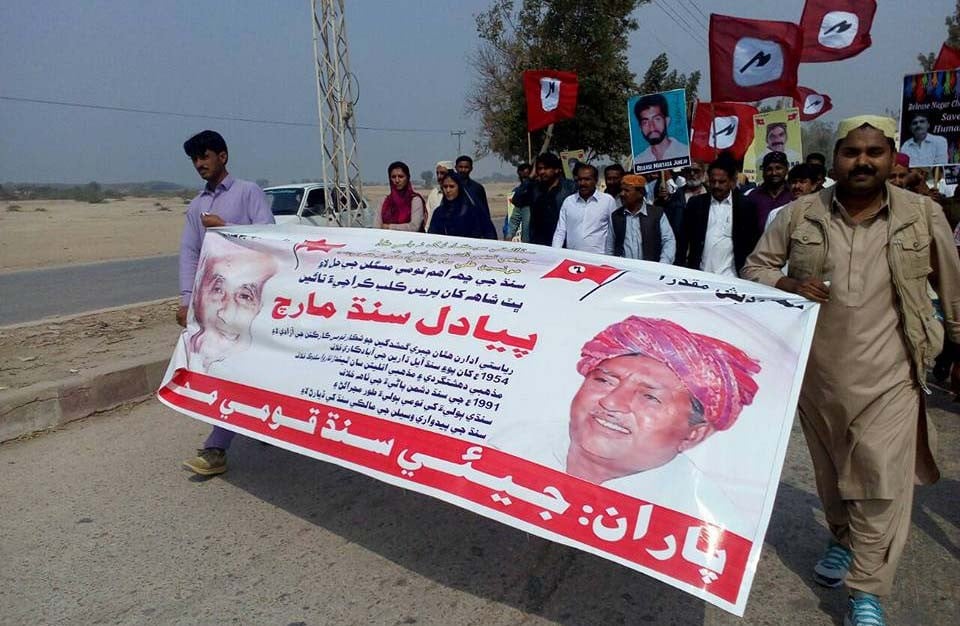
Why are Sindhi activists deserting nationalist politics?

Last week, Kehar Ansari, the Jeay Sindh Qaumi Mahaz (JSQM) secretary general, announced his decision to leave the politics of "red flag" to join quami dhara (mainstream politics). Addressing a meeting at a local press club in Nawabshah, Ansari said he had decided to distance himself from "anti-Pakistan parties" that have no structured programmes for the youth, and only use them for "negative activities".
Ansari’s decision to leave nationalist politics is representative of an ongoing trend in Sindh. Many leaders and workers associated with various factions of Jeay Sindh Tehreek (JST), a self-proclaimed "non-violent movement" founded by legendary GM Syed, have abandoned their politics.
This is because of a quiet and persistent crackdown on the nationalist groups by the law enforcement agencies to curb their allegedly violent activities targeting Chinese interests in the province. This is also fading away their romance with the nationalistic politics.
While Pakistan People’s Party (PPP) represents Sindhis at the national level, the Sindhi ethnic groups exercise substantial influence at the provincial level. Since the demise of GM Syed, who pioneered the Sindhi independence movement in 1972, the JST has split into various factions. The most prominent among them are: (late) Bashir Qureshi-led JSQM, Shafi Burfat-led Jeay Sindh Muttahida Mahaz (JSMM), and (late) Abdul Wahid Aresar-led JSQM.
A number of other leaders -- Abdul Khaliq Junejo, Riaz Chandio, Shafi Karnani, (late) Qamar Bhatti and Safdar Sarki have also led their own factions of the Tehreek. But GM Syed’s grandson, Syed Jalal Mehmood, has kept his Sindh United Party away from JST. Two Sindhi parties -- Ayaz Latif Palijo-led Qaumi Awami Tehreek and the Qadir Magsi-led Sindh Tarraqi Pasand Party -- do not subscribe to Syed’s political ideas.
Broadly speaking, Jeay Sindh groups do not believe in electoral politics. Instead, they struggle for separation of Sindh from Pakistan. JSMM is the only group calling for an armed struggle to achieve its goal. The Ministry of Interior banned the JSMM in 2013 for its alleged involvement in province-wide violence, and placed Burfat, who lives in Europe in self-exile, on its list of wanted persons.
There is a general perception among senior law enforcement officials involved in the crackdown against violent separatist groups that JSMM uses the banned Sindh Desh Liberation Army (SDLA), that operates as an underground force, to carry out attacks on state-run banks, power pylons, rail tracks and other government installations. The activities of JSMM have been controlled since 2014, when its members, along with those representing other Jeay Sindh factions, allegedly launched attacks on Chinese projects in the province. This also led to a rise in the number of cases of enforced disappearances and extra-judicial killings of nationalist workers.
"Initially, the law enforcement agencies’ key target was JSMM and its militant wing, which used university students in subversive activities against the interests of both the state and the Chinese," says a law enforcement official while requesting anonymity. "Later, a wider dragnet was thrown over militants representing other factions, like JSQM’s Qureshi and Aresar factions."
Members of various Jeay Sindh factions blamed Burfat for terror activities and subsequent killings of nationalist workers. "Burfat created unnecessary chaos. It gave the law enforcement agencies justification to control us," says Fareed Malah, a former member of JSQM in Hyderabad.
The crackdown on the nationalist groups may have compelled some activists to desert ethnic politics but Sindhi ethnic parties and human rights groups claim forced disappearances -- including that of Ansari -- are the main reason for the fading away of nationalist politics. They are released on the condition of publicly renouncing their links to Sindhi nationalism, they claimed.
Riaz Sohail, a veteran journalist working with BBC Urdu, says the "mainstreaming" of Sindhi separatist workers started with the implementation of the National Action Plan in January 2015.
He believes another cause of weakening Jeay Sindh politics is lack of iconic leadership. "Qureshi kept his Jeay Sindh faction relevant by aggressively pursuing Sindh-centric issues. Following his death in April 2012, the party started deteriorating. The party leadership was handed over to his son Sannan at a tender age," Sohail adds.
"Nationalist parties used to strive for rights of the Sindhi community -- by staging peaceful protests, hunger strikes, sit-ins and long marches on issues varying from water crises to the influx of illegal immigrants to construction of large dams," says Sattar Zangezo, a political analyst. "These groups draw in support from educated youths belonging to lower-middle and middle classes. Only a very small number of them were used into subversive activities."
Commenting on the state’s undefined policy of mainstreaming the jihadi groups willing to give up militancy, he says, "The state should not mix the issue of Sindhi nationalist workers with jihadis. It must deal with the non-violent politics through dialogue".